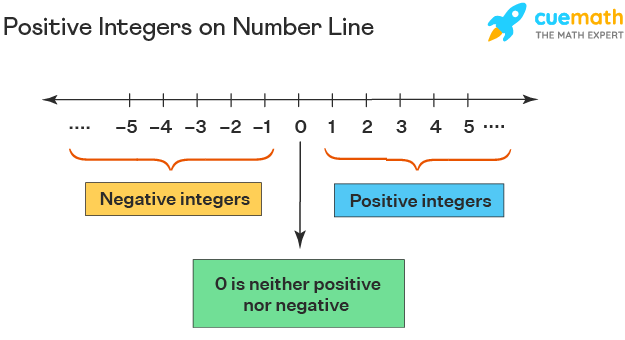Positive Integers
Integers that are on the right side of 0 on a number line are called positive integers. The value of these integers is greater than 0. Another name for positive integers is natural numbers.
| 1. | Positive Integers Definition |
| 2. | Positive Integers Less Than 10 |
| 3. | Set of Positive Integers |
| 4. | List of Positive Integers |
| 5. | FAQs on Positive Integers |
Positive Integers Definition
The definition of positive integers in math states that "Integers that are greater than zero are positive integers". Integers can be classified into three types: negative integers, zero, and positive integers. Look at the number line given below to understand the position and value of positive integers.

Positive Integers Less Than 10
There are 9 positive integers less than 10 which are 1, 2, 3, 4, 5, 6, 7, 8, and 9. In the other way, it can be represented as 0<x<10, or [1, 9].
Set of Positive Integers
The set of positive integers is represented as Z+. It implies all the integers greater than 0. In the roster form, it is represented as {1, 2, 3, 4, 5, 6, 7, ....}. The number of positive integers is infinite as there is no end to the counting. Therefore, the set of positive integers is an infinite set as the number of elements is endless.
List of Positive Integers
The list of positive integers starts from 1 and it goes on up to infinity. So, the positive integers list is 1, 2, 3, 4, 5, 6, 7, 8, 9, 10, 11, 12, 13, 14, 15, 16, 17, 18, 19, 20, ..... and so on. 1 is the smallest positive integer and the greatest positive integer is not known as the list is endless.
► Also Check:
Positive Integers Examples
-
Example 1: Write any 5 positive integers greater than 20 but less than 30.
Solution: 5 positive integers in the range 20<x<30 are 21, 22, 23, 24, and 25. There is a total of 9 integers between 20 and 30, so you can write any 5 of those as the answer.
-
Example 2: What number should be placed in the blank to make the equation correct?
13 + ___ = 54 - 32
Also, state whether it is a positive integer or not?
Solution: The given equation is 13 + ___ = 54 - 32. If we solve RHS first, we get 54-32=22. Now we have to find which number to be added to 13 to get 22. To solve this we have to subtract 13 from 22, which is 22-13=9. Therefore. 9 is the required answer, and it is a positive integer as 9>0.

FAQs on Positive Integers
What are Positive Integers?
Positive integers are the numbers without fractional parts that are greater than 0. These numbers lie on the right side of 0 on the number line.
What is the Difference Between Negative and Positive Integers?
The basic difference between positive and negative integers is that the value of negative integers is less than 0, while the value of positive integers is always greater than 0. On the left side of 0, we will find negative integers, and to the right of 0, we will find positive integers.
What are the First 5 Positive Integers?
The first 5 positive integers are 1, 2, 3, 4, and 5.
Is 0 a Positive Integer?
0 is not a positive integer as it is neither positive nor negative. In math, positive integers are identified as numbers greater than 0.
Which is the Smallest Positive Integer?
1 is the smallest positive integer.
What are Consecutive Positive Integers?
The consecutive positive integers are the consequent or successive integers. We just need to add 1 to the given number to find consecutive integers. For example, 2, 3, 4, 5, 6, and 7 are consecutive positive integers. The difference between each consecutive term is always 1.
What is the Set of Positive Integers?
We know that the set of integers is represented by the symbol Z. So if we add a positive sign to this symbol, we will get the positive integers symbol, which is Z+. Therefore, Z+ is the set of positive integers.
What is the Sum of All Positive Integers?
The sum of all positive integers is infinity, as the number of such integers is infinite.
visual curriculum
